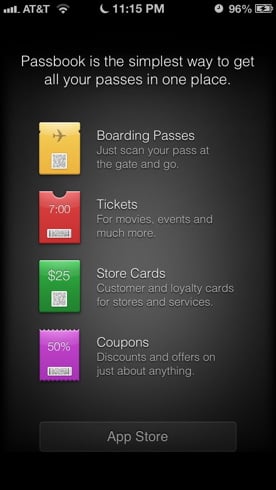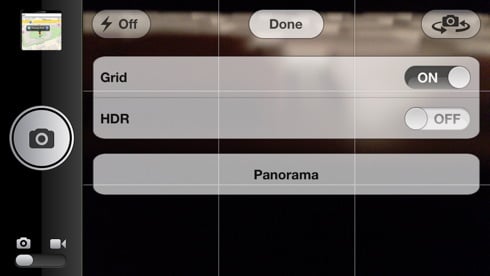iPhone 5 Review: Apple's Best iPhone Yet
User Interface (iOS 6)
We've covered most everything about iOS 6 in a separate article here. It's an entirely new OS, so that warranted a dedicated chunk of digital editorial and analysis. But it's important to discuss how iOS 6 interacts with the iPhone 5 in particular. You see, iOS 6 can also be installed on the iPhone 3GS, iPhone 4, iPhone 4S, the newer iPod touches and the iPad 2 / new iPad. Each one treats iOS 6 differently.
Apple has updated the camera just slightly from the 4S. Most of the specifics are pretty in line from the 4S, and indeed, the images are outstanding. The software is quick, taking multiple photos in a row is excellent, and the new Panorama mode is excellent. There's a line in the middle that adjusts in real time as you sway, and the goal is to keep your phone as close to that line as possible as you pan.
That said, Apple falls short on options here. You can turn on the grid or HDR, and tap to focus, but otherwise your camera options are nil. Why? This is one of the world's best cameraphones, yet you can't tweak the ISO, can't adjust shutter speed and can't adjust aperture. It makes no sense. This has long since been possible on Android, and it would behoove Apple to showcase the iPhone 5 camera's potential even more by giving people the option to tweak the settings. Not saying that many would use it, but some of its photo-minded users would appreciate it.
Siri also works really well, particularly over LTE. LTE is supported on the Sprint, AT&T and Verizon models, with Verizon's existing LTE network being the broadest at present. Siri also does a lot more than she used to, including finding eateries nearby (using Yelp's database), making reservations (using OpenTable), looking up sporting scores and finding movie reviews. However -- and this is a huge however -- most of Siri's features, even the new ones, aren't available outside of the United States. Take a look at this chart to see what Siri features are available where. Clearly, Apple needs to school Siri if it hopes for her to gain momentum outside of its home market.
Siri is also still only partly useful. You can open apps with it, but it's unsatisfying. Siri needs to be able to understand statements like: "Siri, open Navigon and route to 783 Miller St. in Lansing, Michigan." Why is there no open API for Siri integration in third-party apps? It's been a year; this should be a huge priority for Apple.
We also harped on Maps in our iOS 6 piece, but it's worth restating: this is the biggest step backwards for the iPhone 5. For city dwellers -- and there are a ton of those who will be interested in the iPhone 5 -- the native Maps app doesn't support public transit directions. The existing Maps app has a clunky option to download third-party guidance for mass transit; that's very unlike Apple. Worse still, Google has yet to release a standalone iOS Maps app, giving you no real alternative to the way things are in iOS 5. Let's be clear: Apple put out a worse mapping product on its own instead of bending to Google's demands and sticking with them for mapping data.
Perhaps you could argue either way, that Apple shouldn't continue to rely on Google, but Maps is a let down. Yes, it's pretty and turn-by-turn is okay. But TomTom, the company Apple partnered with for Maps, is a lackluster bedfellow. Garmin's mapping data is superior, and TomTom's interfaces have been historically subpar in our opinion. But alas, this is what we're stuck with. We're hoping that Apple updates Maps in short order with mass transit, or that Google comes to the rescue with its own mapping app.
The other knock is that Apple's new mapping application uses Yelp for destinations. It's hard to overstate how much better Google's location database is than Yelp, particularly outside of America. Users who are used to leaning on Google's logic to figure out points of interest in Maps will be pretty upset when they realize those features no longer work.
That aside, iOS 6 hums on the iPhone 5. It does everything iOS 5 did, but with a more polished effort. But it must be said: iOS 6 looks a lot like the original iPhone OS. Since 2007, most of iOS has remained the same. Updates and new features have been added, but the overall feel is the same. iOS is about due for a new look. Look at Android 1.0 compared to 4.1. The updates are significant, and they weren't done for the heck of it; they're useful ones. Hopefully iOS 7 will usher in some newness to an OS that's beginning to look and feel dated. And not by changing design for the sake of it, but by doing some fundamental things better.
Apple has updated the camera just slightly from the 4S. Most of the specifics are pretty in line from the 4S, and indeed, the images are outstanding. The software is quick, taking multiple photos in a row is excellent, and the new Panorama mode is excellent. There's a line in the middle that adjusts in real time as you sway, and the goal is to keep your phone as close to that line as possible as you pan.
That said, Apple falls short on options here. You can turn on the grid or HDR, and tap to focus, but otherwise your camera options are nil. Why? This is one of the world's best cameraphones, yet you can't tweak the ISO, can't adjust shutter speed and can't adjust aperture. It makes no sense. This has long since been possible on Android, and it would behoove Apple to showcase the iPhone 5 camera's potential even more by giving people the option to tweak the settings. Not saying that many would use it, but some of its photo-minded users would appreciate it.
Siri also works really well, particularly over LTE. LTE is supported on the Sprint, AT&T and Verizon models, with Verizon's existing LTE network being the broadest at present. Siri also does a lot more than she used to, including finding eateries nearby (using Yelp's database), making reservations (using OpenTable), looking up sporting scores and finding movie reviews. However -- and this is a huge however -- most of Siri's features, even the new ones, aren't available outside of the United States. Take a look at this chart to see what Siri features are available where. Clearly, Apple needs to school Siri if it hopes for her to gain momentum outside of its home market.
Siri is also still only partly useful. You can open apps with it, but it's unsatisfying. Siri needs to be able to understand statements like: "Siri, open Navigon and route to 783 Miller St. in Lansing, Michigan." Why is there no open API for Siri integration in third-party apps? It's been a year; this should be a huge priority for Apple.
We also harped on Maps in our iOS 6 piece, but it's worth restating: this is the biggest step backwards for the iPhone 5. For city dwellers -- and there are a ton of those who will be interested in the iPhone 5 -- the native Maps app doesn't support public transit directions. The existing Maps app has a clunky option to download third-party guidance for mass transit; that's very unlike Apple. Worse still, Google has yet to release a standalone iOS Maps app, giving you no real alternative to the way things are in iOS 5. Let's be clear: Apple put out a worse mapping product on its own instead of bending to Google's demands and sticking with them for mapping data.
Perhaps you could argue either way, that Apple shouldn't continue to rely on Google, but Maps is a let down. Yes, it's pretty and turn-by-turn is okay. But TomTom, the company Apple partnered with for Maps, is a lackluster bedfellow. Garmin's mapping data is superior, and TomTom's interfaces have been historically subpar in our opinion. But alas, this is what we're stuck with. We're hoping that Apple updates Maps in short order with mass transit, or that Google comes to the rescue with its own mapping app.
The other knock is that Apple's new mapping application uses Yelp for destinations. It's hard to overstate how much better Google's location database is than Yelp, particularly outside of America. Users who are used to leaning on Google's logic to figure out points of interest in Maps will be pretty upset when they realize those features no longer work.
That aside, iOS 6 hums on the iPhone 5. It does everything iOS 5 did, but with a more polished effort. But it must be said: iOS 6 looks a lot like the original iPhone OS. Since 2007, most of iOS has remained the same. Updates and new features have been added, but the overall feel is the same. iOS is about due for a new look. Look at Android 1.0 compared to 4.1. The updates are significant, and they weren't done for the heck of it; they're useful ones. Hopefully iOS 7 will usher in some newness to an OS that's beginning to look and feel dated. And not by changing design for the sake of it, but by doing some fundamental things better.












